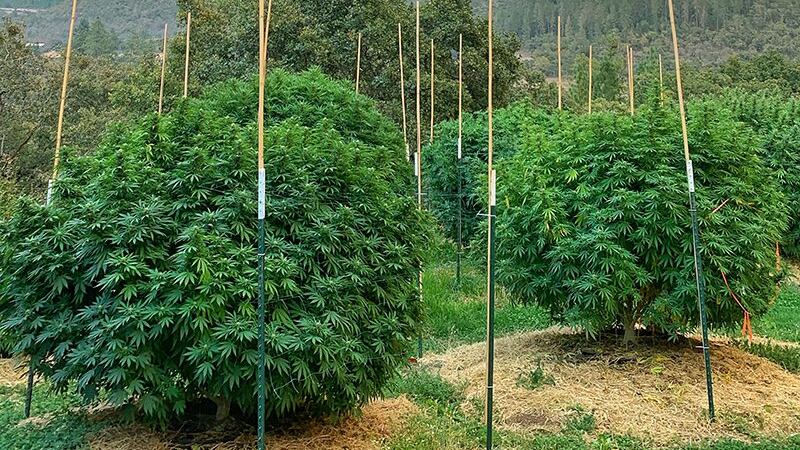On Sept. 8, Roganja co-owner Peter Butch stood in the garden of his family's cannabis farm in Eagle Point, watching as the Obenchain Fire climbed over the ridge bordering his 1-acre grow.
That night, as his neighbors and family evacuated, he used a hose to drench his property until the following morning.
"It just burnt overnight, getting closer and closer, and burnt through my family's property," says Butch. "It [burnt the land] that my dad pioneered."
Butch says only 10% to 20% of the grow was destroyed by ambient heat from the wildfire. But structures used for processing and drying were burnt to ash—as well as his and his mother's homes. His irrigation system and drip lines used to water crop also melted from the heat. He expects there's $300,000 worth of damage to cannabis structures on his property.
"It's gonna cost a lot to rebuild," says Butch. "We were actually having an incredible summer up until these fires hit. Almost smoke-free, a beautiful fall. [And then] we had about nine nights of horribly smoky skies."
As wildfires raged through Southern Oregon this month, where many of the state's cannabis farms are located, farmers found themselves on the fighting end of a natural disaster few saw coming. The blazes came at a particularly inopportune moment: Harvest season has begun, with the bulk of collection happening late this month and through October.
Mark Pettinger, spokesperson for the Oregon Liquor Control Commission, says it's too early to know how much crop damage farmers suffered. But preliminary data gathered by the agency shows that seven cannabis producers reported a complete loss of product, 12 licensees reported a partial loss, and five dispensaries were burnt down.
The devastation to actual cannabis grows has been relatively limited, says economist Beau Whitney—he estimates only about 2% to 4% of the state's supply was impacted. Successful grows need excessive amounts of moisture to survive, and that may have saved many of them from going up in flames.
But damage to the infrastructure of the industry, such as drying and trimming buildings, irrigation systems and the ability of pickers and staff to return to areas that are still under evacuation orders, might be where the trouble lies.
"Unless you have that insurance money coming in, that's a loss," says Whitney. "That's where the impact is: How do you pull up from your bootstraps and get back into the game? That's the real tough part."
And because cannabis is still federally illegal, property and crop insurance is hard for cultivators to access.
As the fires encroached closer to farms, many farmers used primitive measures to protect their grows from catching fire.
At the peak of the wildfires, East Fork Cultivars in Takilma was surrounded on nearly all sides by fires within 1 mile of the property. Co-owner Nathan Howard and a few staff members dumped buckets of water along the border as the flames creeped closer. Other farmers used handheld hoses to soak their properties, tractors to dig fire lines along property borders to stop the fire, and handheld leaf blowers to blow off ash from individual plants. Howard's staff also pulled up shrubs and trees they thought would exacerbate the fires.
Even if ash and smoke cover the plants, Whitney says he's not too worried about farmers being unable to use and sell that flower. Smokier plants can still be used for distillate, though farmers would have to take a profit cut since it is less valuable than smokable flower.
Still, Whitney says the adaptable cannabis market is already using the smoke as a marketing tool.
"I'm seeing some extracted oil brands and names of brands like 'Smokey Joe,'" he says, "so I'm starting to see the market react immediately already."
And even if everyone has a slightly smoky flower this harvest season, "the smoke won't have an impact on the overall market because it'll be so ubiquitous throughout the entire system," Whitney says. "They have to buy something."
Smoke and ash, says Nathan Howard, isn't a big concern for East Fork, as it's had a small crew hand-watering plants and removing toxins that have settled from the smoke—and anyway, smoke is a natural deterrent to the particular mold endemic to cannabis plants, Howard says.
Instead, the concern for Howard is the ethical quandary of whether to allow salaried farm staff back despite unhealthy air quality. Takilma is still under Level 3 evacuation orders, and though East Fork has had several local employees volunteering to survey the plants, the crew of seasonal pickers probably won't come back.
That could spell trouble for harvest season, which has already begun and picks up in force through October.
"We're potentially facing devastation if we go into next week and can't invite our team back," says Howard. "We have many thousands of pounds of cannabis that need to be harvested next week."
Rhea Miller, who co-owns Millerville Farms with her husband, Matt, is neighbors with East Fork. She says she's been obsessing over whether to even harvest the plant, which she says is covered in a thick layer of ash.
"I've been analyzing different outcomes, as far as taking the loss and bulldozing it down now and stop spending money on it, to harvesting it and exploring extraction or harvesting once cut and seeing how it smells," says Miller. "We learned from the cannabis glut of 2017: If you don't know where the plant is going or what it's doing, don't touch it."

